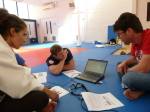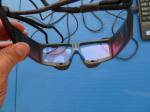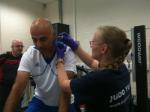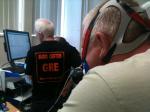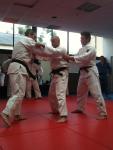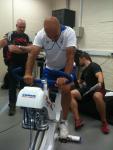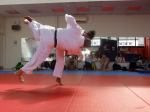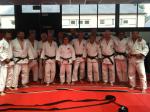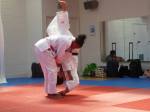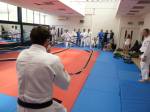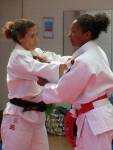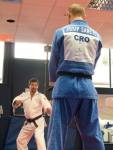Many studies have looked at the physiological responses to a single judo contest (Cipriano, 1993; Degoutte et al, 2003; Sterkowicz & Maslej, 2000; Wolach, et al, 2003) but in reality, to become a successful judo athlete, several judo contests must be fought in succession. On a single day of competition, a judo player can expected to have 4-8 fights (Cipriano, 1993; http://www.ippon.org) in order to win a gold medal; there is usually a gap between each fight of approximately 20-30 minutes. In training athletes are expected to fight 10-15 fights back to back in order to master the technical skill in a combat situation within the time constraints of a lesson/session (Inman, 2004), it should be noted that the success of Japanese judo has been attributed to the number of fights in training being much higher and their duration longer.
Studies have shown that Olympic wrestling and judo are physiologically similar (Pulkkinen, 2001). Studies into judo and wrestling have shown a high anaerobic contribution to both sports (Nilsson, et al, 2002; Pulkkinen, 2001; Sterkowicz & Maslej, 2000), indeed Pulkkinen (2001) suggests that the ATP-CP system and the anaerobic system are the primary sources of energy during a judo contest.Personally I am not convinced that wrestling and judo are as similar as some researchers suggest, certainly time motion research suggests they are very different and anyone who has done both wrestling and judo will tell you they are physically very different.
Time-motion analysis (Cipriano, 1993; Sterkowicz & Maslej, 2000) has shown that judo contests are characterised by maximal (100% VO2) efforts of 10-15s interspersed with recovery periods of sub-maximal efforts that include pushing, pulling and lifting movements.I will be doing a separate post on time motion analysis in judo at a later date.
The anaerobic system has a tremendous ability to completely replenish stores after depletion within 2-3 minutes (Astrand & Rodahl, 1986). High lactate scores have also been observed in judo contests (Callister et al, 1991; Nilsson et al, 2002; Sikorski et al, 1987), these authors have reported lactate scores of between 8.4mmol and 17.2mmol.
Several authors have suggested the following attributes, normally based upon the physiological profile of high performance athletes:
• Strength
• Power
• Speed
• Agility
• Balance
• Anaerobic power and endurance within a large aerobic base
• Flexibility
At Anglia Ruskin University we are investigating the demands of high performance judo in two ways. Firstly my PhD research is focussing on the time motion analysis of light weight women’s judo. You can see the pro’s and con’s of time motion analysis in the previous post. Secondly the next block of the European Judo Union Level 4 performance coach award and Level 5 high performance coach award will focus on physiology. By educating and equipping coaches we hope to further our understanding of the physiological demand of judo. For now though more information on judo physiology can be found by sourcing the reference list.
If you have any questions about the physiological demands of judo please ask in the comments below.
References:
Angus, R. (2006). Competitive Judo. Human Kinetics. Printed in USA.
Astrand, P., Rodahl, K., Dahl, H.A., Str∅mme, S.B. (2003). Textbook of Work Physiology. Physiological bases for exercise. (4th ed). Human Kinetics. Printed in Canada.
Baechle, T.R. & Earle, R.W. Eds. (2002). Essentials of Strength and Conditioning (2nd ed). National Strength and Conditioning Association. Human Kinetics. Printed in China.
Bell, G.J., Syrotuik, D., Martin, T.P., Burnham, R., & Quinney, H.A. (2000). Effects of concurrent strength and endurance training on skeletal muscle properties and hormaone concentrations in human. European Journal of Applied Physiology. 81: 418-427.
Bompa, T.O. (1999). Periodization. Theory and Methodology of Training. Human Kinetics. Printed in USA.
Brown C.H. & Wilmore, J.H. (1974). The effects of maximal resistance training on the strength and body composition of women athletes. Medicine and Science in Sports. 6(3): 174-177.
Callister, R., Callister, R.J., Saron, R.S., Fleck, S.J., Tesch, P. & Dudley, G.A. (1991). Physiological characteristics of elite judo athletes. International journal of sports medicine. 12, 196-203
Chimera, N.J., Swanik, K.A., Swanik, C.B. & Straub, S.J. (2004). Effects of plyometric training on muscle-activation strategies and performance in female athletes. Journal of Athletic training. 39(1): 24-31.
Chu, D.A. (1996). Explosive power & strength. USA: Human Kinetics. Chu, D.A. (1998). Jumping into plyometrics. 2nd ed. USA: Human kinetics
Cipriano, N. (1993). Technical-tactical analysis of free-style wrestling. Journal of strength and conditioning research. 7 (3): 133-140
Degoutte, F., Jouanel, P. & Filaire, E. (2003). Energy demands during a judo contest and recovery. British journal of sports medicine. 37:245-249.
Dick, F.W. (2002). Sports Training Principles. 4th Ed. A & C Black (Publishers) Ltd. Printed in Great Britain.
Dudley, G.A., Abraham, W.M & Terjung, R.L. (1982), Influence of exercise intensity and duration on biochemical adaptations in skeletal muscle, journal of applied physiology, 53, (4), 844-850
Etnyre, B.R. and Lee, E.J. (1987). Comments on Proprioceptive neuromuscular facilitation stretching techniques. Research Quarterly. 58: 184-188.
Hewett, T.E., Stroupe, A.L., Nance, T.A. & Noyes, F.R. (1996). Plyometric training in female athletes. American Journal of Sports Medicine. 24:765-773.
Hoffman, J. (2002). Physiological Aspects of Sport Training and Performance. Human Kinetics. Printed in USA.
Kraemer, W. J., Häkkinen, K, Triplett-Mcbride, N.T., Fry, A.C. Koziris, L.P., Ratemess, N.A. Bauer, J.E. Volek, J.S., Mcconnell, T.,
Newton, R.U., Gordon, S.E., Cummings, D., Hauth, J., Pullo, F., Lynch, J.M., Mazzetti, S.A. and Knuttgen H.G. (2002). Physiological Changes with Periodized Resistance Training in Women Tennis Players. Medicine and Science in Sports and Exercise. 35 (1):157–168.
Leveritt, M., Abernethy, P.J., Barry, B.K. & Logan, P.A. (1999). Concurrent Strength and Endurance training. Sports Medicine. 28(6): 413-427.
McCarthy, J. P., Pozniak, M.A & Agre, J.C. (2002). Neuromuscular adaptations to concurrent strength and endurance training. Medicine and Science in Sports Exerercise. 34 (3): 511–519.
Moshanov, A. (2006). Lecture: Performance Planning – Sports Training Science University of Bath. FdSc Sport Performance (European Judo Union).
Nilsson, J., Csergo, S., Gullstrand, S., Tveit, P. & Refsnes, P. (2002) Work-time profile, blood lactate concentrations and perceived level of exertion in the 1998 Greco-wrestling world championship. Journal of sports science 20: 939-945
Pulkkinen, W. J. (2001). The Sport Science of Elite Judo Athletes. A review and application for training. Pulkinetics. Printed in Canada.
Selye, H. (1956). The stress of life. Printed in New York. McGraw-Hill. IN: Baechle, T.R. & Earle, R.W. Eds. (2002). Essentials of Strength and Conditioning (2nd ed). National Strength and Conditioning Association. Human Kinetics. Printed in China.
Shrier, I. (1999). Stretching before exercise does not reduce the risk of local muscle injury: a critical review of the clinical and basic literature. Clinical Journal of Sports Medicine. 9:221-227.
Sikorski, W., Mickowicz, G., Maole, B. & Laska, C. (1987). Structure of the contest and work capacity of the judoist. Polish judo association. Institute of sport: Warsaw, Poland IN: Pulkinnen, W. (2001). The sports science of elite judo athletes: A review and application for training. Pulkinetics. Printed in Canada.
Sterkowicz, S & Maslej, P (2000).An evaluation of the technical and tactical aspects of judo matches at the senior level. Division of combat sports. Academy of physical education. Krakow: Poland.
Thacker, S.B., Gilchrist, J., Stroup, D.F. & Kimsey, C.D. (2004). The impact of stretching on sports injury risk: A systematic review of the literature. Medicine and Science in Sport and Exercise. 36(3): 371-378.
Tomlin, D.L. & Wenger, H.A. (2001). The relationship between aerobic fitness and recovery from high intensity intermittent exercise. Sports Medicine. 31(1):1-11.
Weers, G. (1997). Skill Range of Elite Judo Players. Judo information website. http://www.judoinfo.com. Last accessed 17th April 2006.
Weldon, S.M. & Hill, R.H. (2003). The efficacy of stretching for the prevention of exercise related injury: a systematic review of the literature. Manual Therapy. 8:141-150.
Wolach, B., Falk, B., Gavrielli, R., Kodesh, E. & Eliakim, A. (2000). Neurophil function response to aerobic and anaerobic exercise in female judoka and untrained subjects. British journal of sports medicine. 34:23-28.
Zatsiorsky, V. ed. (2000). The encyclopaedia of sports medicine. Biomechanics in sport, Performance enhancement & injury prevention. Cambridge: Blackwell sciences.
If you enjoyed this post please share it with your friends:





